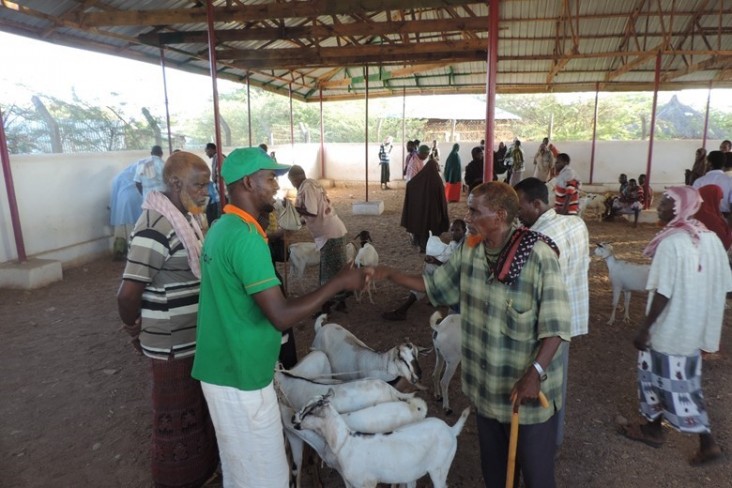
December 2016—Somalia is one of the lowest performing countries in the world in terms of economic growth, gender equality and human development. The government is still rebuilding after its collapse 25 years ago and struggles to provide even basic health and education services. Only five years ago, parts of Somalia were devastated by a famine.
But outcomes from USAID programs demonstrate that a fragile state like Somalia is the right place to invest in innovative approaches to build resilience.
In Gedo region’s Luuq village, community members rehabilitated a livestock market in November-December 2015 through USAID cash-for-work activities, building roofs and holding pens, and constructing toilets. Since the rehabilitation, sales of sheep, goats and donkeys have doubled, the market stays open twice as long, and side businesses, such as tea stalls and food stands, have popped up along the periphery.
The rehabilitation also supports Somali women’s empowerment—the women trading sheep and goats are the majority of sellers in the market.
In another village in Gedo region, members of savings and loans groups initiated by USAID invested in a butchery, generating revenue for the group and expanding the community’s diet by providing a local and affordable source of meat. The village never had a functional butchery before then.
These savings groups not only invest in small-scale business ventures, they also function as short-term safety nets during times of crisis. Some savings groups in Sanaag region hired water trucks in August 2016 to supply their communities during drought and some have provided food to elderly and vulnerable people in neighboring communities in times of need.
“The savings groups is one good innovation because it places power in the hands of the community in the long term,” says Hassan*, a young Somali.
“The Somali people are resilient. Their successes in strengthening local livestock markets and supporting the wider community through savings groups show they are eager to stand on their own with some help from USAID,” says Paul Majarowitz, division chief at USAID’s Office of Food for Peace.
The 2011 drought in the Horn of Africa jump-started much of the resilience work USAID is doing in the region today. And USAID continues to support a robust humanitarian response in Somalia where 5 million people—40 percent of the population—are acutely food insecure. The challenges of weak infrastructure, climate change and insecurity from violent extremist groups remain, but there are opportunities in Somalia to do more than relief.
USAID, through its partners, is reaching 145,000 Somalis with programs that combine humanitarian and development efforts so communities transition from being recipients of emergency relief to having the capacity to prepare for and withstand the inevitable shocks they face. And with humanitarian needs outpacing funding around the world, building resilience is an integral part of the solution.
“With results like the ones in Gedo and Sanaag regions, USAID’s efforts in Somalia are helping make the case for smart investments in resilience,” says Majarowitz. “We cannot afford to wait until the next crisis hits and lose what the Somali people have worked hard to gain. We need to help people get ahead of shocks and stay on the pathway to development.”
*Name changed to protect identity.
RELATED LINKS
Follow @USAIDSomalia, on Facebook, on YouTube







Comment
Make a general inquiry or suggest an improvement.